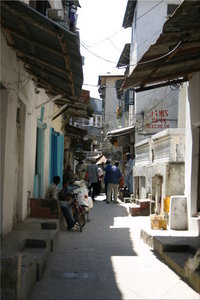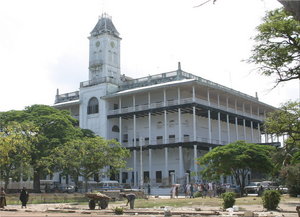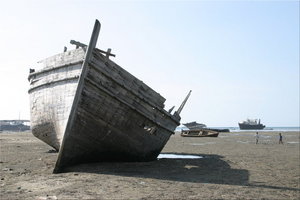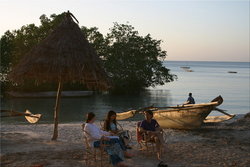
To get into town, Bruce has explained that we can be normal tourists and take a taxi, or, for 20 cents each, we can get up close and personal with the locals on the public transit system. This we must try.
Public transit here is the "Dala Dala" system. A Dala Dala is a pickup truck (usually Toyota) with a "U" of benches in the back, and a roof. A conductor stands on the back running board, and solicits customers, which are packed in until the vehicle has the legal maximum of 20 passengers in the back, or rather, until it is no longer humanly possible to squeeze anyone else in, and often two passengers in the cab as well. There is an electrical signal button which is never used; instead the conductor bangs on the metal tubing of the superstructure with coins; two bangs means go, three bangs means stop, I think.

|
|
Several Dala Dalas
|
The pace is frantic, with the vehicle usually well under way before the conductor hops back on, with speeds of I think 80km/h reached between stops. There are Dala Dalas everywhere, all packed full of passengers. Cool young dudes with sunglasses, devout robed muslims, housewives with children, habited nuns, you name it. The longest we ever wait for one is two minutes, with 30 seconds being more typical. Each vehicle is operated, I think, as a private enterprise so they compete with each other for passengers, but there is no shortage of customers. A quintet of white tourists draws some surprised glances. But that's OK with us. I love it.
The Dala Dalas converge on their downtown terminus, which is a dusty lot across from the central market.

|
|
A typical alley in Stone Town
|
Stone Town is a world heritage site. Tourist literature emphasizes the crisp, picturesque white buildings. This is the first place we see in Africa that has an architectural history.
In real life though, this is no preserved museum piece. It is hot and it smells, and the buildings are crumbling. Lots of people live here. The tourism industry is still new, not yet in high gear. Restaurants are few, the hotels are hard to find. The main waterfront park is full of dead grass and garbage. All this is quite a culture shock, though I will find that after a couple of days here, one starts to tune it out, and notice more of the nice stuff, the picturesque little alleys, the interesting angles, the way the late afternoon sunlight plays on a whitewashed wall.
I love diving into the maze of Stone Town with just a general direction in mind, and wandering down alleys which, hopefully, I have not been in before. With enough wandering you discover everything. A store that actually has Hostess Pringles (Andrew's favourite potato chips). An actual North American style supermarket. A video arcade. Internet places charging $1/hour. Islamic places of prayer. Woodwork shops. An auto body shop. Schools. A guy cranking sugarcane through a metal press to produce glasses of a cloudy beverage that the locals drink, with flies buzzing around. Really eclectic hotels. The only trouble is finding a given place again later.
We walk down the tourist alleys, where every store is a curio shop full of carvings, Masai beadwork, paintings and banana leaf pictures. We emerge on the waterfront. Anywhere cars can go, we can't walk 100 yards without someone offering us a taxi ride.

|
|
The House of Wonders
|
The House of Wonders is the grandest building in all of Zanzibar. It was designed in 1883 by a Scottish marine engineer, and has been used since then as an administrative center by the British when they ruled here, and as a palace by a couple of sultans. Currently, we find, it is used as the national museum. It costs $3 per person to get in. So used am I to haggling by now that without even thinking I ask for a group rate for 5 people. We are let in for the price of four.
The museum is not bad inside. It has, as its centerpiece, an old wooden Dhow (the local kind of sailboat) that is constructed without nails, the planks actually being sewn to the ribs with ropes. Apparently nails were not used until the Europeans came here. In a corner, there is a small outrigger fishing boat. It is virtually identical to the boats parked on the beach in front of our hotel, which are in current use. Boat construction has not really changed here in hundreds of years.
We eventually end up on the balcony, on which one can walk all around the building, and admire the view from there. Andrew spots a Christian church in the distance, which we will later try to find, unsuccessfully, in the maze of streets.
The only bad thing about the House of Wonders is the washrooms, which don't seem to get much maintenance.
After we finish here, we stop for ice cream at the Tembo hotel, and then find our way by trial and error back through Stone Town to the Dala Dala terminus, where the others go off to the hotel, but I wander off again in a different direction. I want to see the harbour.

|
|
On the tide flat
|
The tidal flat is great. I take pictures all over, and initially intend to walk north until I find a good way back onto safe ground. But several people shout to me that it is not safe. I figure as long as they continue hammering on their boats, I'm probably OK, but I eventually retrace my steps out the way I came. About an hour later, I find that the tide has risen enough so that the flat would now be flooded, not deeply mind you, but one's feet would get wet.
I pass a boat builder's encampment. Here, Dhows are constructed by methods unchanged for centuries. Ribs are being whittled out of crooked wood with axes. Two wiry men in their 50s are whipsawing a log into planks by hand. I am not sure if I would cause offense by taking a photo, so I miss a great picture. Another man is working on a sail.

|
|
Beach Paradise
|
Then I catch a passing Dala Dala and am whisked back to the hotel. There, I once again go swimming in the beautiful, lukewarm clear Indian Ocean. I intend to get out of the water in time to photograph the sunset, but I swim too slowly and miss it. In the evening, we go to eat at the hotel restaurant again. The service is even slower than last time, even though we (and Bruce and a special guest from Italy) are the only customers.
About the last thing we do today is to try to photograph the moonset. Once again, I sleep like a log.